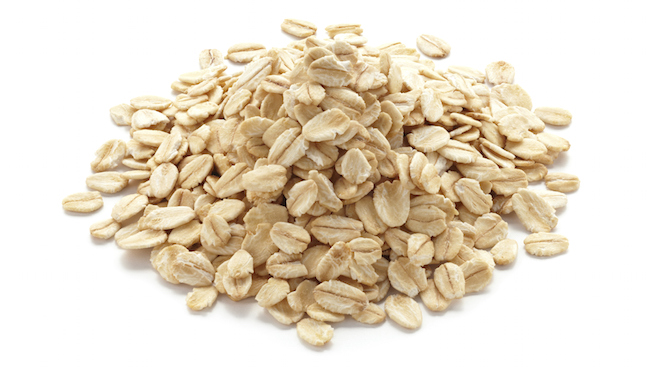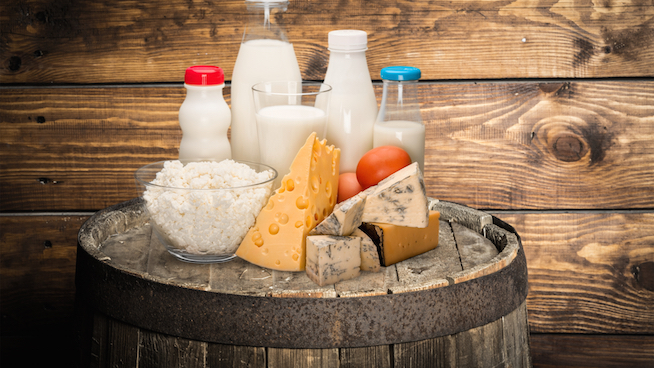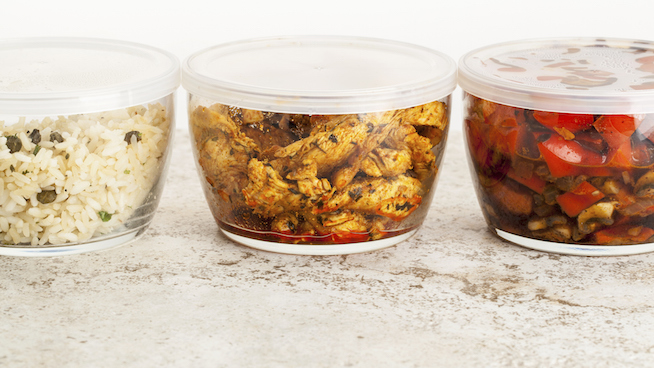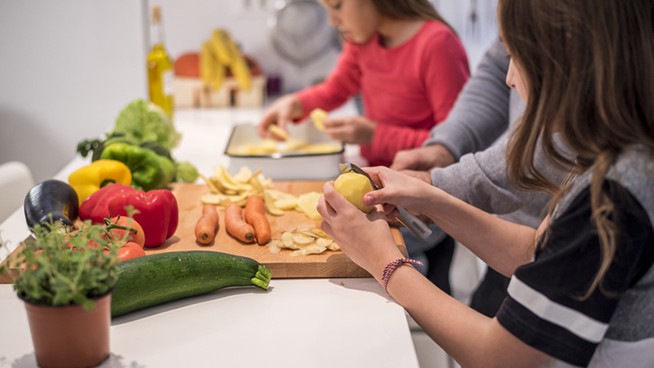9 Foods to Eat When You Want to Lose Fat
When you track macros, eat Paleo, or go on a juice cleanse, you can stave off some of that nagging hunger if you can trick your brain into thinking you’re eating more food.
One way to do this is to eat foods that are low in calories but high in volume. High-volume foods take longer to eat and fill you up, making them stellar foods for fat loss. These foods typically have low-fat, high-fiber and high-protein content. Eating higher amounts of protein and fiber should keep you full and satisfied, and since fat is more calorie dense than protein or carbohydrates, a lower fat intake keeps the overall calories low.
Cauliflower
The big reason why this cruciferous veggie is at the top of the list is its versatility. You can make everything from pizza crust to macaroni and cheese with it.
Aside from all the recipe possibilities, cauliflower is rich in vitamins C and K, which are great for reducing inflammation and reducing free radical damage. Like most foods on this list, it delivers a big dose of fiber in each serving to support digestive health. With all the fiber and antioxidants, cauliflower is a powerhouse for immune function.
Peppers
Adding peppers to omelets or egg scrambles, fajitas and stir fry is an awesome way to increase the volume of food you’re eating. Not to mention, they have a nice crunchy texture and tons of flavor.
Colorful fruits and vegetables are your best bet for getting a wide array of antioxidants. Different colors typically represent different types of antioxidants. A red fruit or vegetable, for example, typically contains compounds that protect against heart attacks and neurological diseases. Yellow and orange veggies are high in beta carotenes like vitamins A and C, which promote eye health and immune function. It’s a good thing peppers are grown in almost every color of the rainbow.
Leafy Greens
Leafy greens are nutritional superstars, and one of the best foods for fat loss. They are jam packed with minerals like manganese, iron, potassium, and magnesium, which aid in everything from blood sugar regulation to muscle and nervous system function.
Egg Whites
Egg whites contain the majority of the protein in an egg, and, when cooked, they take up some serious plate real estate. I’m all for eating the yolk of the egg; it contains most of the nutrients and it’s awfully tasty. But that’s also where most of the calories come from.
For a high-volume meal, add liquid egg whites to a few whole eggs. If you’re feeling a little crazy, add spinach and peppers to up the volume even more and significantly increase your micronutrient intake.
Oats

I’m not talking about flavored and microwaveable oats. I mean whole grain oats that, when cooked, are so filling you can’t eat more than a 1/2 cup at a time. Oats contain high amounts of B vitamins, which are essential for metabolism and other bodily processes. You also get a big dose of soluble fiber from oats to lower your risk for heart disease and blood sugar irregularities.
Pro tip: Cook up a bowl of oats, then mix in protein powder, some type of nut butter and banana. It’s been known to satisfy a few cravings here and there, and provide some great nutrients.
Popcorn
This is a super high-volume snack for the people who struggle later in the day or at night. I like buying whole kernel corn and popping it on the stove with a tiny bit of coconut oil.
Rice Cakes
Rice cakes are amazing for snackers, or for people (like me) who needs some crunch in their diet. With flavors ranging from white cheddar to apple cinnamon, they can satisfy any craving. Although the flavored versions are ripe with artificial flavoring, the main ingredient list is short. If you choose the plain version, you will likely find only two ingredients, rice and salt. Similar to popcorn, rice cakes are not the most nutrient-dense snack you could have, but for fat-loss diets, staying the course and keeping your sanity are top priorities.
PB2
If you are a Food Babe fan, or one of those all-natural all-the-timers, you may want to quit reading here. PB2 is powdered peanut butter, and it tastes amazing. The fat is removed in the processing of the peanuts, rendering a low-calorie, versatile food. By adding a bit of water, you have a few servings of creamy peanut butter with less than 100 calories. This is also a great option for shakes and smoothies. Who doesn’t love chocolate, peanut butter and banana?
Greek Yogurt
You can use this versatile high-protein food in tons of recipes. Your options include everything from fruit and vegetable dip to protein ice cream and milkshake-consistency smoothies. Greek yogurt provides a large dose of high-quality amino acids to support muscle growth and recovery as well as calcium for bone health and organ function. Like other types of yogurt, it gives you a decent serving of probiotics to promote a healthy digestive system.
Always go with plain yogurt and add your own sweetener or fruit. Greek yogurt contains some natural sugars in the form of lactose, so you should not add any extra sugar in the ingredient list. By using things like Stevia or Splenda, along with real fruit or other ingredients, you can keep the calories low and nutritional value high.
[cf]skyword_tracking_tag[/cf]RECOMMENDED FOR YOU
MOST POPULAR
9 Foods to Eat When You Want to Lose Fat
When you track macros, eat Paleo, or go on a juice cleanse, you can stave off some of that nagging hunger if you can trick your brain into thinking you’re eating more food.
One way to do this is to eat foods that are low in calories but high in volume. High-volume foods take longer to eat and fill you up, making them stellar foods for fat loss. These foods typically have low-fat, high-fiber and high-protein content. Eating higher amounts of protein and fiber should keep you full and satisfied, and since fat is more calorie dense than protein or carbohydrates, a lower fat intake keeps the overall calories low.
Cauliflower
The big reason why this cruciferous veggie is at the top of the list is its versatility. You can make everything from pizza crust to macaroni and cheese with it.
Aside from all the recipe possibilities, cauliflower is rich in vitamins C and K, which are great for reducing inflammation and reducing free radical damage. Like most foods on this list, it delivers a big dose of fiber in each serving to support digestive health. With all the fiber and antioxidants, cauliflower is a powerhouse for immune function.
Peppers
Adding peppers to omelets or egg scrambles, fajitas and stir fry is an awesome way to increase the volume of food you’re eating. Not to mention, they have a nice crunchy texture and tons of flavor.
Colorful fruits and vegetables are your best bet for getting a wide array of antioxidants. Different colors typically represent different types of antioxidants. A red fruit or vegetable, for example, typically contains compounds that protect against heart attacks and neurological diseases. Yellow and orange veggies are high in beta carotenes like vitamins A and C, which promote eye health and immune function. It’s a good thing peppers are grown in almost every color of the rainbow.
Leafy Greens
Leafy greens are nutritional superstars, and one of the best foods for fat loss. They are jam packed with minerals like manganese, iron, potassium, and magnesium, which aid in everything from blood sugar regulation to muscle and nervous system function.
Egg Whites
Egg whites contain the majority of the protein in an egg, and, when cooked, they take up some serious plate real estate. I’m all for eating the yolk of the egg; it contains most of the nutrients and it’s awfully tasty. But that’s also where most of the calories come from.
For a high-volume meal, add liquid egg whites to a few whole eggs. If you’re feeling a little crazy, add spinach and peppers to up the volume even more and significantly increase your micronutrient intake.
Oats

I’m not talking about flavored and microwaveable oats. I mean whole grain oats that, when cooked, are so filling you can’t eat more than a 1/2 cup at a time. Oats contain high amounts of B vitamins, which are essential for metabolism and other bodily processes. You also get a big dose of soluble fiber from oats to lower your risk for heart disease and blood sugar irregularities.
Pro tip: Cook up a bowl of oats, then mix in protein powder, some type of nut butter and banana. It’s been known to satisfy a few cravings here and there, and provide some great nutrients.
Popcorn
This is a super high-volume snack for the people who struggle later in the day or at night. I like buying whole kernel corn and popping it on the stove with a tiny bit of coconut oil.
Rice Cakes
Rice cakes are amazing for snackers, or for people (like me) who needs some crunch in their diet. With flavors ranging from white cheddar to apple cinnamon, they can satisfy any craving. Although the flavored versions are ripe with artificial flavoring, the main ingredient list is short. If you choose the plain version, you will likely find only two ingredients, rice and salt. Similar to popcorn, rice cakes are not the most nutrient-dense snack you could have, but for fat-loss diets, staying the course and keeping your sanity are top priorities.
PB2
If you are a Food Babe fan, or one of those all-natural all-the-timers, you may want to quit reading here. PB2 is powdered peanut butter, and it tastes amazing. The fat is removed in the processing of the peanuts, rendering a low-calorie, versatile food. By adding a bit of water, you have a few servings of creamy peanut butter with less than 100 calories. This is also a great option for shakes and smoothies. Who doesn’t love chocolate, peanut butter and banana?
Greek Yogurt
You can use this versatile high-protein food in tons of recipes. Your options include everything from fruit and vegetable dip to protein ice cream and milkshake-consistency smoothies. Greek yogurt provides a large dose of high-quality amino acids to support muscle growth and recovery as well as calcium for bone health and organ function. Like other types of yogurt, it gives you a decent serving of probiotics to promote a healthy digestive system.
Always go with plain yogurt and add your own sweetener or fruit. Greek yogurt contains some natural sugars in the form of lactose, so you should not add any extra sugar in the ingredient list. By using things like Stevia or Splenda, along with real fruit or other ingredients, you can keep the calories low and nutritional value high.
[cf]skyword_tracking_tag[/cf]


















